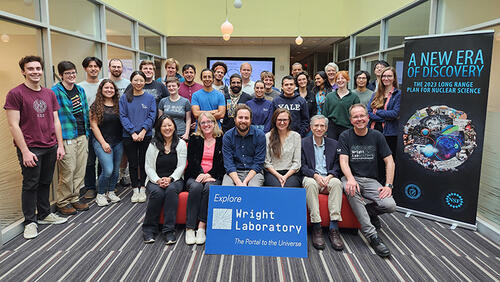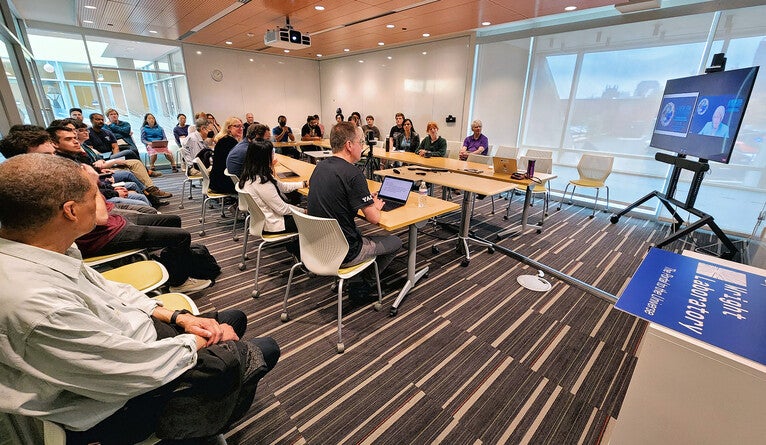
Yale will play a role in several initiatives highlighted in the Nuclear Science Advisory Committee’s long-range plan for nuclear physics research.
By Jim Shelton
The federal government’s Nuclear Science Advisory Committee (NSAC), which provides official advice to the U.S. Department of Energy and the National Science Foundation, has approved a long-range plan for nuclear physics research in the next decade — and it includes key contributions from Yale.
On Oct. 6, Yale’s Wright Lab hosted a regional webinar in which NSAC Chair Gail Dodge outlined the long-range plan. Yale faculty members, administrators, staff, and students were on hand to discuss Yale’s role in several of the plan’s initiatives, which encompass cutting-edge experiments, theoretical modeling, and efforts to broaden education and employment opportunities for the next generation of scientists.
“This is an exciting time for the science we do for Yale and for the nation,” said physics professor Larry Gladney, dean of science and the Phyllis A. Wallace Dean of Diversity and Faculty Development in Yale’s Faculty of Arts and Sciences. “I’m excited about the future of nuclear physics and the idea that we will help develop the workforce who will propel this work going forward.”
“A New Era of Discovery: The 2023 Long Range Plan for Nuclear Science” is the eighth plan approved by NSAC since 1979. The 103-page report, Dodge said, highlights scientific opportunities in nuclear physics that will enable the U.S. to maintain world leadership in nuclear physics.

Reina Maruyama
It makes four overall recommendations:
- Capitalize on U.S. investments in scientific discovery by increasing funding for research; continuing the effective operation of national research facilities; expanding opportunities in science by raising compensation of graduate students; and expanding policy and resources to ensure a safe and respectful environment.
- Lead an international consortium to investigate the existence of neutrinoless double beta decay — a process that would show that neutrinos are their own antiparticles and could help explain the dominance of matter over antimatter in the universe.
- Complete the construction of the Electron-Ion Collider (EIC) at Brookhaven National Laboratory in Long Island, New York — a unique, high-luminosity electron-hadron collider capable of colliding high-energy beams of polarized electrons with heavy ions, polarized protons, and polarized light ions.
- Invest in additional, innovative projects in emerging technologies and discoveries, including detectors, quantum sensors, and high-performance computing.
“It is great to see that much of the research being pursued at Wright Lab is highlighted as a top priority in the 2023 Long Range Plan for Nuclear Science,” said Wright Lab Director Karsten Heeger, the Eugene Higgins Professor and chair of the Department of Physics in the Faculty of Arts and Sciences. “Both the search for neutrinoless double beta decay and the Electron-Ion Collider are recommended as highest priority for new projects with major discovery potential.”

Indeed, Yale researchers are working on several projects mentioned in the report.
Associate professor of physics David Moore’s team, for example, is involved in the neutrinoless double beta decay experiment nEXO (Yale will build a photon detector for the experiment) and the quantum information and technology experiment QuIPS (it will apply quantum sensors to the search for nuclear decays).
Physics and astronomy professor Reina Maruyama is co-spokesperson and Heeger is a principal investigator for the neutrino experiment CUORE. Heeger is also co-spokesperson for the ton-scale neutrinoless double beta decay experiment CUPID and a principal investigator for Project 8, a project to measure neutrino mass.
Physics professors Helen Caines and John Harris have had leadership roles in both the ALICE and STAR collaborations, which are based at the Relativistic Heavy-Ion Collider at Brookhaven and the Large Hadron Collider at CERN in Geneva, Switzerland. The collaborations explore the nature of quark-gluon matter. Newly hired assistant professor of physics Laura Havener is a member of the ALICE collaboration.
Caines and Havener are also active in detector research and development at Wright Lab for the ePic experiment, which will be installed at Brookhaven’s planned EIC.
Yoram Alhassid, the Frederick Phineas Rose Professor of Physics, is a theoretical physicist whose group has developed new methods in the realms of nuclear “many-body theory,” cold atomic quantum gases, and high-performance computing.
Faculty members also voiced strong support for national efforts to encourage a supportive research environment.
“We are very pleased to see the top recommendation highlighting the need to create a safe and supportive workplace environment for research to thrive,” Caines said. “Wright Lab and the physics department highly value this important aspect of the workplace and developed a ‘Statement of Principles’ for our community four years ago.”
Yale was one of 21 sites that hosted events announcing the new NSAC report.
This article was originally published in Yale News on October 17, 2023.

